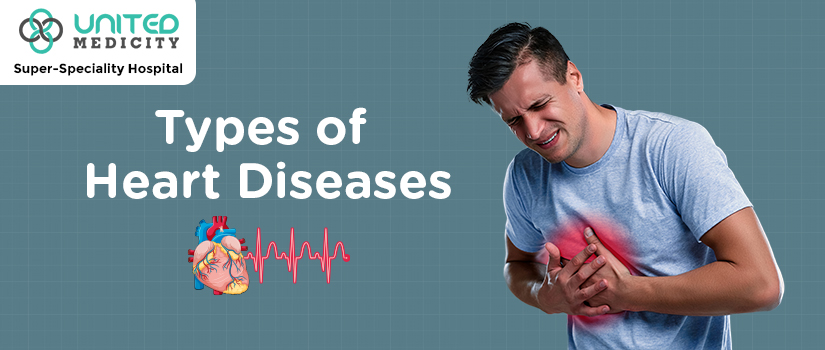The human heart, that relentless pump tirelessly circulating blood throughout our bodies, is a remarkable organ. But this vital powerhouse is vulnerable to various conditions collectively known as heart disease. Recognizing these different types of diseases is crucial for catching problems early, preventing them, and managing their impact.
Let’s take a closer look at the diverse spectrum of heart diseases:
Different Types of Heart Disease
Coronary Artery Disease (CAD): This is one of the most common types of diseases, ACTUALLY, common heart conditions. It happens when the coronary arteries narrow or get blocked, usually due to plaque buildup. This constriction limits blood flow to the heart, leading to chest pain, heart attacks, or myocardial infarctions.
Hypertensive Heart Disease: When high blood pressure persists, it forces the heart to work harder, causing problems like heart failure, thickening of the heart muscle, or coronary artery disease.
Cardiomyopathy: This condition messes with the heart muscle, affecting its ability to efficiently pump blood. There are different types, including dilated cardiomyopathy (enlarged and weakened heart chambers), hypertrophic cardiomyopathy (thickened heart muscle), and restrictive cardiomyopathy (stiffened heart muscle).
Arrhythmias: These are irregular heart rhythms, which can show up as either a rapid heartbeat (tachycardia) or a slow one (bradycardia). Atrial fibrillation, a common arrhythmia, heightens the risk of stroke and heart failure.
Valvular Heart Disease: The heart’s valves control blood flow in and out of its chambers. Conditions like aortic stenosis, mitral valve prolapse, or endocarditis fall under this category.
Congenital Heart Defects: These are heart structural issues present at birth. They range from simple conditions not causing symptoms to complex defects needing immediate medical attention.
Pericardial Diseases: The pericardium, the heart’s protective sac, can suffer from conditions like pericarditis (inflammation), pericardial effusion (fluid accumulation), or constrictive pericarditis (stiffening).
Heart Failure: Contrary to its name, it doesn’t mean the heart stops, but rather it struggles to pump blood effectively. It can result from various underlying conditions and shows up as fatigue, shortness of breath, and fluid retention.
Knowing the differences between these types of diseases is crucial for accurate diagnosis and the right treatment. Managing heart conditions might involve lifestyle changes, medications, surgeries, and cardiac rehabilitation. Additionally, preventive measures like regular exercise, a balanced diet, avoiding tobacco, and stress management are vital in reducing heart disease risks.
Wrap Up
In conclusion, the multitude of different types of diseases highlights how complex cardiovascular health is. With advancements in medicine, early detection through screenings, coupled with lifestyle changes and timely treatments, significantly improves outcomes for those at risk or already dealing with heart conditions. Prioritizing heart health through awareness, education, and proactive healthcare measures remains crucial in lessening the global burden of cardiovascular diseases.

10 Comments
UqfpOSgFKvdWhrt December 31, 2023 at 4:43 am
BweOHyfg
VmCJwxBL January 10, 2024 at 5:17 pm
RbQwjCgzZaP
oGiXFOCInyjgr April 25, 2024 at 6:41 pm
BJbTQFvaCq
qwgSXabzCEfUGTPo May 12, 2024 at 2:45 am
MAGRTazuIy
cOyhdqAsWriSfQGU June 10, 2024 at 2:31 pm
vDbjMNkTWp
TPikVEKAwp August 4, 2024 at 4:35 am
CuPyKHvQXfZGBJ
tlovertonet August 13, 2024 at 9:02 pm
I do not even know how I ended up here, but I thought this post was great. I don’t know who you are but certainly you’re going to a famous blogger if you aren’t already 😉 Cheers!
Phillip Inman August 15, 2024 at 5:57 pm
Bookmarked, so I can continuously check on new posts! If you need some details about Thai-Massage, you might want to take a look at UQ4 Keep on posting!
LhSsijbVoNJqerdY September 14, 2024 at 6:16 pm
cAJVtkqCnLl
Corey Bacino January 24, 2025 at 7:34 pm
“It’s awesome to pay a quick visit this web site and reading the views of all mates concerning this paragraph, while I am also zealous of getting experience.”